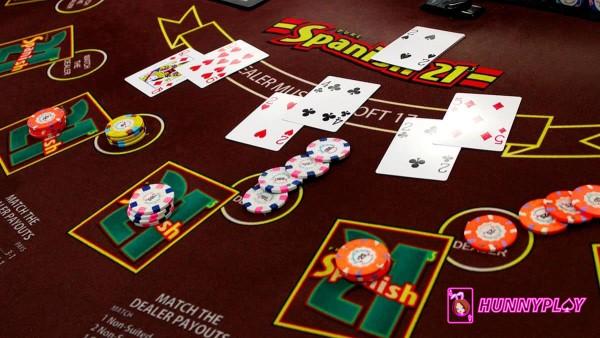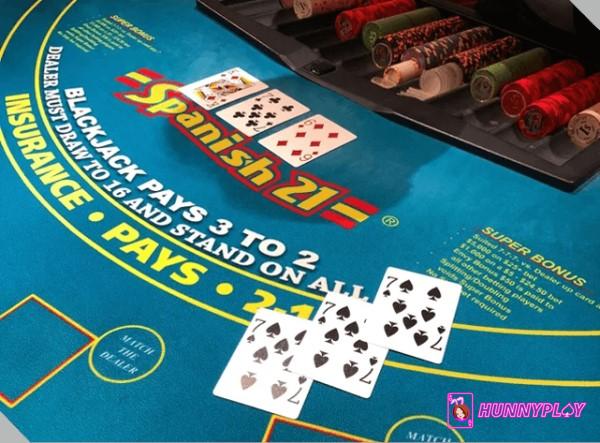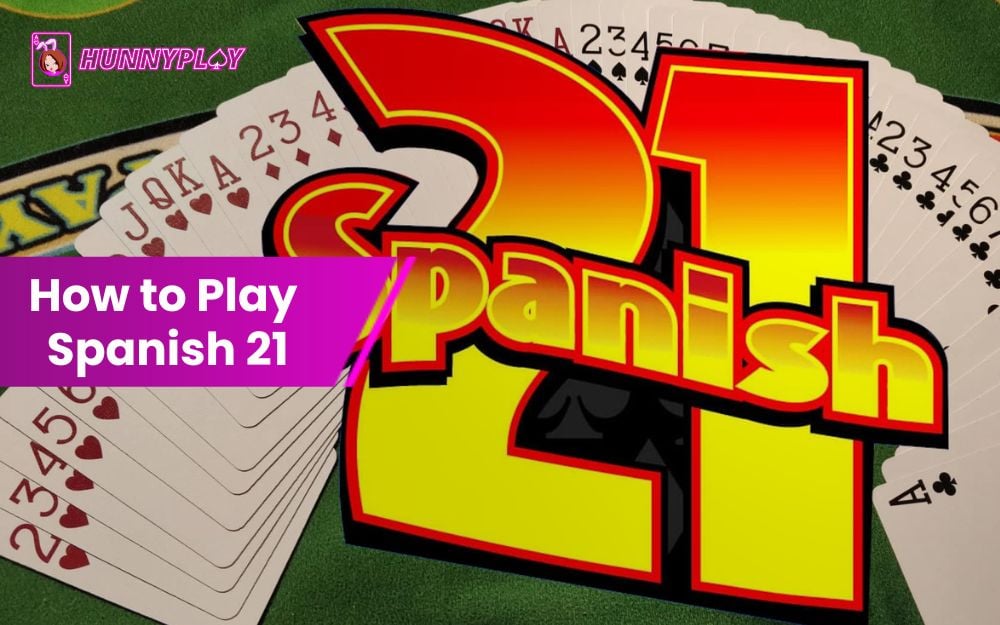Spanish 21 is a fast-growing variation of Blackjack that offers unique twists and winning strategies. In this guide, HunnyPlay will walk you through how to play Spanish 21, covering everything from basic rules to expert tips, so you can maximize your chances of winning.
What is Spanish 21?
Spanish 21 might seem like an exotic twist, but it’s essentially a variation of a familiar favorite—Blackjack. What sets it apart are the unique winning opportunities created by specific card combinations.
While the core rules remain unchanged, ensuring accessibility for beginners, Spanish 21 introduces intriguing variations that appeal to seasoned players eager for a fresh challenge.
These tweaks to the traditional game not only add excitement but also offer strategic depth, making it a compelling choice for those seeking something beyond the standard Blackjack experience.

Basic rules of Spanish 21
The basic rules of how to play Spanish 21 closely mirror those of traditional Blackjack. Your primary objective is to achieve a hand totaling 21 or as close to it as possible without exceeding that number.
The game begins with each player and the dealer receiving two cards. Typically, players get one card face up and one face down. In some variations, players might receive both cards face up, while the dealer has one card hidden.
Once you’ve received your initial cards, you can choose to “hit”—taking another card—or “stand”—keeping your hand as it is. You can continue hitting until you either reach 21 or bust by going over.
A significant distinction between Blackjack and Spanish 21 is that all 10s are removed from the deck in Spanish 21, which alters the game’s dynamics.
A Blackjack occurs when your first two cards total 21—specifically, a combination of a face card (Jack, Queen, or King) and an Ace (valued at 1 or 11, depending on your hand). If the dealer draws a Blackjack, they win automatically.
However, if no one has a Blackjack, the player closest to 21, without exceeding it, wins the round.
How to play Spanish 21
Once you’re familiar with the basics of Blackjack, you’re well on your way to understanding Spanish 21.
However, mastering this variation requires learning some advanced rules that not only increase your chances of winning but also heighten the excitement of the game.
Objective
The goal in Spanish 21 mirrors that of Blackjack: to reach 21 or get as close as possible without exceeding it.

The objective in Spanish 21 is just like in Blackjack: aim to hit 21 or get as close as you can without going over. (Source: Internet)
Key differences and payouts
The main distinctions in Spanish 21 gameplay come from the absence of 10s in the deck and the unique betting strategies that yield different payouts for various combinations. Here’s a breakdown of those combinations:
- 5-Card 21: Pays 3:2
- 6-Card 21: Pays 2:1
- 7+ Card 21: Pays 3:1
- 6-7-8 Mixed: Pays 3:2
- 6-7-8 Suited: Pays 2:1
- 6-7-8 Spaded: Pays 3:1
- 7-7-7 Mixed: Pays 3:2
- 7-7-7 Suited: Pays 2:1
- 7-7-7 Spaded: Pays 3:1
Hit
The dealer automatically wins if they land a Blackjack. However, if their face-up card isn’t a Jack, Queen, King, or Ace, it’s safe to assume they don’t have a Blackjack.
In this case, you should aim to get as close to 21 as possible. If your hand’s value is low, it’s wise to hit.
Stand
If you believe your hand is near its optimal value close to 21, you should stand—meaning you stop taking additional cards.
You might even stand with a hand as low as 14 if you’re wary of busting. Ultimately, your decision to stand depends on your risk tolerance and the likelihood of drawing a high-value card.
Surrender
If you’re not confident in your hand’s potential, you can choose to surrender. This means forfeiting half of your bet and conceding the hand.
Surrendering can be a strategic move, especially if you’re fairly certain you won’t win, as it minimizes your losses to just half the bet.
Double Down
When you’re confident that one more card could seal the deal, consider doubling down. This option is popular when you have a hand totaling 11, as the odds of drawing a face card (bringing you to 21) are favorable.
Doubling down requires you to double your bet, but you only receive one additional card.
Split
If your initial two cards form a pair, you can split them into two separate hands. You’ll need to place an additional bet on the second hand, and then you can play each hand independently, hitting and betting as you see fit.
Take Insurance
If the dealer’s face-up card is an Ace, you can opt for insurance, which costs half your original bet. If the dealer does achieve a Blackjack, the insurance pays out at 2-1, offering some protection against a potential loss.
By understanding and employing these strategies, you’ll be better equipped to navigate the nuances of Spanish 21 and make informed decisions that enhance your gameplay.

Spanish 21 hand signals have many similarities to classic Blackjack. (Source: Internet)
How to play Spanish 21: Strategies and tips
Basic strategies of Spanish 21
Mastering the rules of how to play Spanish 21 is essential to enhancing your gameplay.
To increase your chances of winning, you need to thoroughly understand how to achieve 21, familiarize yourself with all betting options—such as splitting, doubling down, and surrendering—and grasp the specific payouts for this game.
Armed with this knowledge, you’ll be able to make strategic decisions on when to hit, stand, or bet. Beyond that, the outcome depends on luck.
Here are some key strategies to remember:
- A player’s natural Blackjack always triumphs over the dealer’s Blackjack.
- Spanish 21 allows for late surrender, offering more flexibility.
- You can even surrender after doubling down, which is unique to this variant.
- Aces can be split multiple times, providing additional opportunities to form winning hands.
- Doubling down after splitting is also permitted, giving you more chances to maximize your bets.
By keeping these strategies in mind, you can approach each hand with confidence and increase your odds of success in Spanish 21.
Tips to win at Spanish 21
Mastering Spanish 21 requires more than just knowing the rules—it demands strategic thinking and a keen understanding of the game’s nuances.
While the list of tips can be extensive, here are some key strategies to help you start on the right foot:
- Always hit when your hand totals a hard 4 through 8, or 12.
- Always hit on soft hands valued at 13 or 14 (a soft hand includes an Ace).
- Double down when you have a hand valued at 11, as your chances of reaching 21 are high.
- Stand firm on hands with a hard 18 or higher—pushing your luck may lead to a bust.
- Never split a pair of 4s or 5s, as these hands are more valuable together.
- Stand strong with a pair of 10s; splitting them weakens your position.
- Always split a pair of Aces to maximize your chances of forming strong hands.
This list is just the beginning—start by committing these essential tips to memory. As you become more comfortable with the game and these strategies become instinctual, you can gradually incorporate more advanced techniques into your play.

Winning Spanish 21 demands strategic thinking and a keen understanding of the game’s nuances. (Source: Internet)
Why should you play Spanish 21 at HunnyPlay?
HunnyPlay is a top choice for enthusiasts of Spanish 21. We are known for our extensive game selection and user-friendly platform. Here’s what sets HunnyPlay apart.
- Vast Game Library: Access over 10,000 games, including free Bitcoin slots, Keno, bingo, classic table games, live dealer experiences, etc.
- Crypto-Friendly: Play with your preferred cryptocurrency, with in-game values displayed in your chosen currency for a smooth experience.
- Generous Bonuses: Enjoy a 300% deposit bonus plus 100 free spins as a welcome gift, daily rewards, and an excellent referral program.
- User Experience: Benefit from an easy registration process, 24/7 live support, and regular community updates.
- VIP Club: Unlock exclusive rewards and benefits by joining the VIP Club for the most dedicated players.
- Global Reach: Supports multiple languages and cryptocurrencies, making it accessible to a diverse international audience.

How to play Spanish 21: FAQs
Q: How is Spanish 21 different from Blackjack?
A: Spanish 21 shares many similarities with traditional Blackjack but offers more options and unique payouts. A key difference is the removal of all numbered “10” cards, leaving 48 cards in each deck.
However, Jacks, Queens, and Kings still count as 10, and Aces can be valued at 1 or 11, depending on what benefits the player most.
Q: What are the rules of Spanish 21?
A: The basic rules of Spanish 21 align closely with those of Blackjack. The objective remains the same: to form a hand totaling 21 or as close as possible without exceeding it.
Q: Why is it called Spanish 21?
A: The name “Spanish 21” originates from its use of a 48-card Spanish deck, even though Spain may or may not be Blackjack’s original home.
Q: How many times can you double down in Spanish 21?
A: In Spanish 21, players have the option to double their wager up to three times—initially through a double down, followed by two additional double-double down opportunities.
Conclusion
How to play Spanish 21 is all about understanding its unique rules, strategic options, and maximizing your winning potential.
Whether you’re a seasoned player or new to the game, Spanish 21 offers an exciting twist on traditional Blackjack, making it a must-try for any casino enthusiast. Head over to HunnyPlay and start playing Spanish 21 today!




















